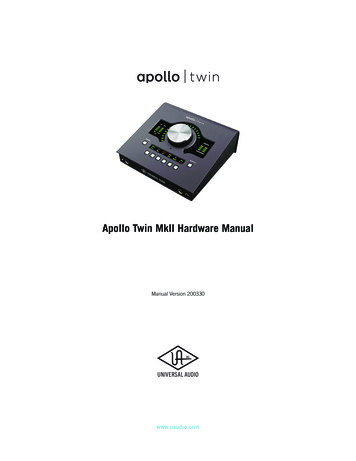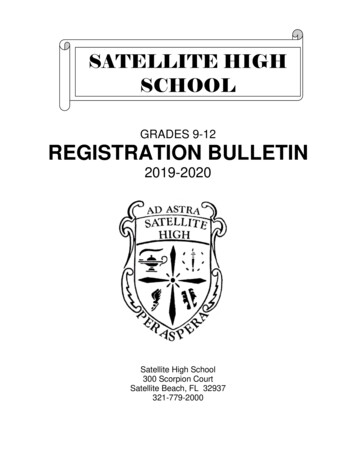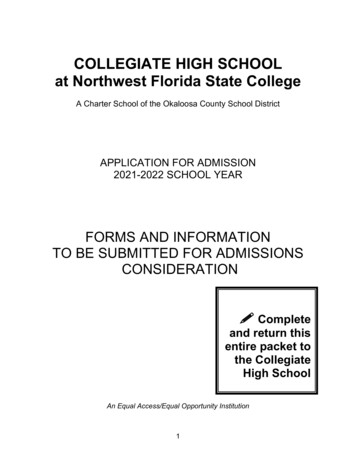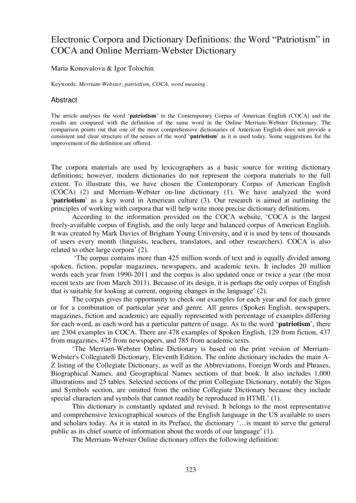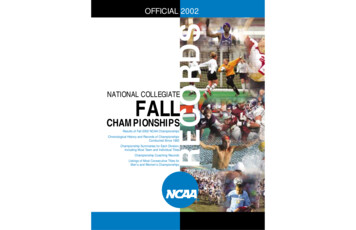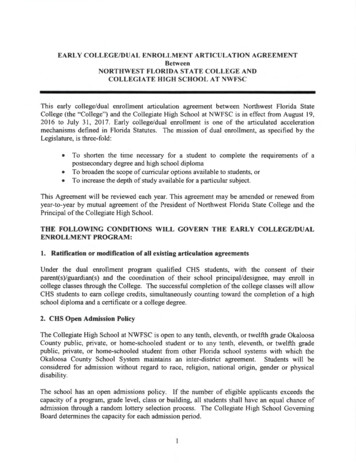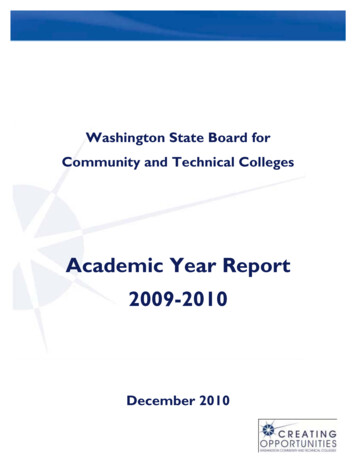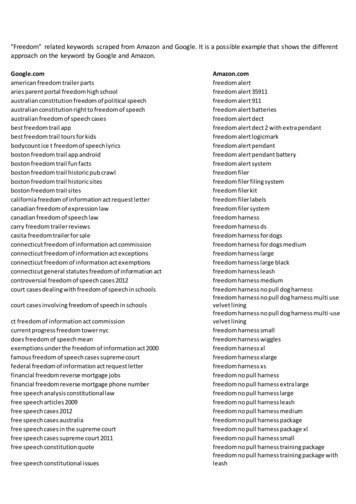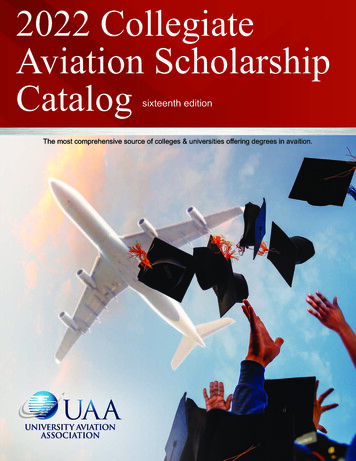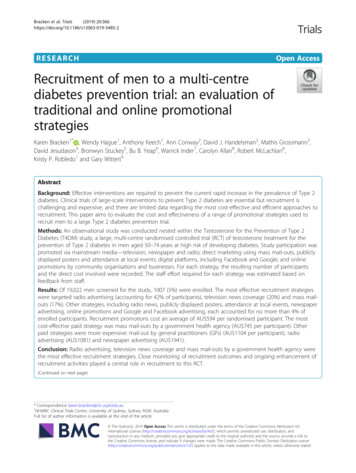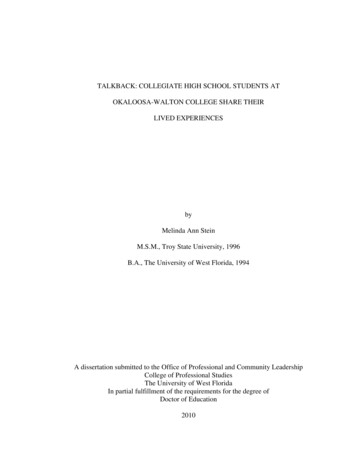
Transcription
TALKBACK: COLLEGIATE HIGH SCHOOL STUDENTS ATOKALOOSA-WALTON COLLEGE SHARE THEIRLIVED EXPERIENCESbyMelinda Ann SteinM.S.M., Troy State University, 1996B.A., The University of West Florida, 1994A dissertation submitted to the Office of Professional and Community LeadershipCollege of Professional StudiesThe University of West FloridaIn partial fulfillment of the requirements for the degree ofDoctor of Education2010
2010 Melinda Ann Stein
The dissertation of Melinda Ann Stein is approved:Robin M. Largue, Ed.D., Committee MemberDateJill T. White, Ed.D., Committee MemberDateJanet K. Pilcher, Ph.D., Committee ChairDateAccepted for the Department/Division:Thomas J. Kramer, Ph.D., ChairDateAccepted for the University:Richard S. Podemski, Ph.D., Dean of Graduate StudiesDate
ACKNOWLEDGMENTSMy journey in the doctoral program began at the insistence of my good friend andcolleague Brian Shonk. We have traveled this path together for over 3 years and Icelebrate as we cross the finish line. Dr. Mary F. Rogers kept me going in the programwhen times were tough. She guided me with patience and care. She will always have aspecial place in my heart.I greatly appreciate the willingness of the staff of the Collegiate High School forallowing me open access to the school. A special thanks goes to Mary Jane Robertson forher assistance during the months of observations, focus group meetings, and individualmeetings with the students. I also appreciate the willingness of the Collegiate HighSchool students for sharing their lived experiences with me. It was a pleasure to get toknow each and every one of those students.I am grateful for my mom, who was supportive through my months and years ofstudy. I am thankful for my many friends and coworkers who encouraged me to goforward and pursue my dream.I dedicate this dissertation to my dad who was not able to hold on to see mecomplete this degree. He was my biggest cheerleader. He instilled the value of educationupon me at a young age. He expressed his confidence in my ability to accomplish thisgoal, and he encouraged me on a daily basis to make it happen. I miss him every day.iv
TABLE OF CONTENTSACKNOWLEDGMENTS . ivABSTRACT . viiCHAPTER I.INTRODUCTION .1A. Collegiate High School .7B. CHS Graduation and Graduates .11C. Statement of Purpose .14CHAPTER II.REVIEW OF THE LITERATURE .16A. School Choice Movement .18B. Charter School Movement .20C. Student and Parent Perceptions .34CHAPTER III.METHODS .44A. Research Site .46B. Research Participants .49C. Data Collection .51D. Data Management and Analysis .54E. Validity in Qualitative Research .56F. Theoretical Perspectives .58CHAPTER IV.PARTICIPANTS AND FOCUS GROUPS .64A. Participant Selection .68B. Focus Groups .711. The Engaged Learners .722. The Nonengaged Learners .78C. Summary .85CHAPTER V.THE INDIVIDUAL INTERVIEWS AND OBSERVATIONS .87A. Engaged Learners: Individual Interviews and Observations .891. Bunny .892. Red .943. Athena .97B. Nonengaged Learners: Individual Interviews andObservations .1011. Sunshine .1012. John .104v
3. Missy .1084. Stone .111CHAPTER VI.DISCUSSION .113A. Themes .122B. Recommendations for Future Study .125C. Summary .126REFERENCES .128APPENDIXES .136A. Informed Consent Form .137B. The University of West Florida’s Institutional ReviewBoard Approval .141C. Permission to Interview Students.143vi
ABSTRACTTALKBACK: COLLEGIATE HIGH SCHOOL STUDENTS ATOKALOOSA-WALTON COLLEGE SHARE THEIRLIVED EXPERIENCESMelinda Ann SteinThis is a comparative case study of the lived experiences of students at theCollegiate High School located on the main campus of Okaloosa-Walton College inNiceville, Florida. This qualitative research study focused on the thoughts, feelings, andlived experiences of selected Collegiate High School students. The study also addressedthe participants’ relationships with the faculty, staff, and other students and their opinionsabout the Collegiate High School’s environment and culture. The theoretical perspectivesof dramaturgy and care theory framed the analysis of the study. Generated data indicated3 themes that emerged. First, the students at the Collegiate High School feel cared for bythe teachers and staff. Second, the students at the Collegiate High School enjoy the smallnumber of students enrolled in the school and feel a sense of community because of thesmall size of the school. And third, the students at the Collegiate High School feel theyhave an identity at the school. In addition to that identity, the students feel they havefreedom, independence, and choice.vii
CHAPTER IINTRODUCTIONFinally, after working 10 years at Okaloosa-Walton College (OWC), I landed mydream job. In May 2001, I was selected to be the OWC Center Director of Education atEglin Air Force Base. I had prepared for my interview, but I was still a bit shocked whenI learned I had been chosen from a pool of 52 applicants. Although my new job wouldnot start for another 4 months because I was replacing someone retiring from theposition, I quickly began making lists of things I knew had to be done at the OWCEducation Center at Eglin. For four months, I visited my future office and observed theoperations of the Center. I could hardly wait to move to the Center and start my new job.My career took a big turn off that new track on September 11, 2001. Shortly afterthe terrorist attacks in New York, Pennsylvania, and Washington, DC, Eglin Air ForceBase administrators announced that security on the base would be elevated to the highestlevel. This meant OWC could no longer offer classes to nonmilitary personnel on thebase. So OWC went from offering 85 classes there each semester to only six classes. Inmy heart, I knew there would no longer be a need for my new position. My fears wereconfirmed when I was called into the college president’s office shortly afterwards.Although I learned that the college would no longer have that position, it did have a newjob for me. This position centered on assisting our Vice President of Instruction.1
Moving to the Office of Instruction was a shock for me. I had spent my first 10years at the college as a payroll technician, an accountant, a facilities coordinator, and abusiness office manager. Project management was my specialty, yet somehow I hadended up on the instructional side of the house. My very first day on the job was filledwith meetings. One meeting that I recall was about our Collegiate High School (CHS)that had begun 1 year earlier. As I walked through the CHS building, I observed the CHSstudents standing in the hallways and sitting in the classrooms. It was like a flashback tohigh school for me as I thought of my own experiences while I was in high school and Iwondered about the lived experiences of these high school students. Are their experiencessimilar to the experiences I had in high school over 25 years ago? Or are theirexperiences completely different from my high school experiences? I wanted to know theanswer to these questions. In that particular meeting, I listened closely as administratorsdiscussed operations, parent concerns, and issues arising at the nascent CHS. Then, everythought I ever had about growing up and education came flooding back.I was born and raised in the small town of Madisonville, Louisiana. When I wasgrowing up there, Madisonville was no more than a sleepy little town. Children playedoutdoors, and most days around the neighborhood were quiet. My family consisted of mymom and dad and my four siblings—three sisters and one brother. We were a blendedfamily. My oldest sister was my dad’s child, my brother and next to oldest sister were mymom’s children, and then there were my younger sister and I—the only two children ofmy mom and dad as a couple.My dad was a welder. He had worked for the Equitable Shipyard his entire life.Except for a short stint when he was drafted in the Army at an early age and went to2
Chicago for 3 years, he had spent his whole life in Madisonville. My dad was actuallyborn in the house next door to where my parents still live today. He loved to fish, hunt,and trap. On most weekends, if he was not working overtime at the shipyard, you couldfind my dad out in his little skiff fishing. Many times, you could also find my youngersister, Kim, and me with him.My mom was a homemaker who spent her days cooking, cleaning, and lookingafter the children. A large family was nothing new to her. My mom was one of 14children. Her dad was a janitor, who working the night shift at a hospital, slept most dayswhile she was growing up. Her mom was a homemaker. She had to be with 14 children.In order to help with the smaller children, my mom quit school in the seventh grade.Gone were her days of learning to read and write and do subtraction, addition, andmultiplication. My mom’s life became one of cooking, cleaning, and helping with heryounger sisters and brothers. She also had the job of picking vegetables from the garden.It was also her job to collect the eggs laid that morning and cook them for breakfast fortwins Donice and Janice, sisters Carolyn and Julia, and brothers Otis, Earl, Alton, Adrian,Kenneth, Douglas, Gary, and Marion. Her long days were full of babysitting and chores.School was not part of the picture.Our large family lived in a typical, wooden, shotgun house. As a matter of fact,my parents still live there today. The left side of the house includes a living room, diningroom, and a kitchen. The right side of the house consists of several bedrooms, allconnected without doors between them. At the back of the house is a small bathroom.Back then, the house was heated with one floor to ceiling heater and cooled with a3
gigantic window fan. Although we did not have a lot of money, we did spend good timesthere together as a family.Some of those good times involved my dad telling me how important it is to get agood education. My very earliest memories are of his telling me to do well in school, totry my best to learn, and to get as much education as I could. My dad was very aware ofthe challenges my mom faced because of her lack of education. My mom never could geta good job. Without a high school education or job experience and with her first child at16, my mom was limited to odd jobs that she never really liked and that paid very little. Ido not think my mom chose the life of a homemaker. I think that was the only route shesaw open to her.My mom struggled to write out checks (she could not spell very well) and to helpus with our homework. She wanted to help us more, but it was often impossible. So she,too, pushed her children to get an education. She wanted all of us to live a life differentfrom hers. She wanted us to have chances that she never had. My mom, then, became ourbiggest cheerleader. Although helping with the homework was not her specialty, shecould keep us fed with the best home cooked, hot meals and cheer us on from thesidelines. I can smell her red beans and rice cooking right now.Although no one in my family at this point had ever gone to college, or evenconsidered college, my dad constantly told me that I would need a college education inorder to have a better life than he or my mom had. He wanted me to succeed. He wantedme to be happy. He wanted me to get everything out of life that I desired. He wanted meto earn that good life, and to him, that path to a good life necessitated a college education.4
My dad had never thought about a college education for himself. He hadgraduated from high school in 1942 after 11 years of schooling. The 12th grade was notan option as high school only went through the 11th grade at that time. My dad especiallyliked math. He could multiply and divide four and five digit numbers in his head fasterthan I could punch the numbers into a calculator and get the answer. But in his day, ayoung person either finished high school or did not and then went to work. Everyone hadto make a living, and in our small town, many people worked at the shipyard. My dad’sfather, his brother, and many cousins all worked in different jobs at the local shipyard. Ican remember seeing my dad in his work clothes and steel-toe boots as if it wereyesterday. And, of course, I cannot forget about the metal helmet and shield he had towear on a daily basis to protect his head from the welding flames. To this day, he blamesthat heavy helmet for his thinning hair.From the earliest age I can remember, my dad read to me every single night. I hadmany books as a child, but not a lot of toys. By the time I enrolled in kindergarten, Icould read quite well. My parents remembered my standing out first as a kindergartnerand then a first grader because I read so well. My classmates were impressed. All myelementary school teachers seemed impressed as well. My dad thought an early start onreading would jump start my education. He was right.Eventually, Madisonville Junior High School, which included grades one throughnine, became a big part of my life. We lived near the school so I walked to and fromschool every day. Once home, a small snack was in order. My snack always consisted ofsome kind of sweet treat and a Coca-Cola . Oreo cookies and chocolate chip cookieswere my favorites. About the time I would finish my snack, my dad would get home from5
work. Like clockwork, he showered, got dressed, and headed to the living room to hearfrom my younger sister and me. Kim is only 11 months younger than I. Our other siblingsare older by many years, so they were not part of this routine. No matter what, we knewthat once dad made it to the living room to see us, play time was over.My dad always asked about school. What did we do that day? What did we learnthat day? What new thing could we show him that we could not show him before? Hewanted to hear about our entire day in school. Once he heard from both of us, it was timeto hit the books. Whether we had assigned homework or not, Kim and I had to dohomework. All the while, he would remind us of the importance of an education.According to my dad, people who were educated did not have to work in the shipyard.People who were educated could be teachers and doctors and lawyers. People who wereeducated could do more things in life. People who were educated lived in houses with airconditioners and showers and could take nice vacations. People who were educated couldwork in a worthwhile job of their own choosing and do something they loved. Peoplewho were educated could help others because they would have the ways to do so. Everyday, my sister and I heard how important an education was. And yes, my dad alwaystalked about college. He only knew that my sister and I should get a college degree, nothow to go about it. We would look into that more once we were older.When my sister and I started studying, we would go from one subject to the nextand review materials we had worked with in class that day. If we had homework or a testthe next day, our dad was right there looking over our shoulders to help. Many nights, Iremember giving my dad my books and notebooks, and he would grill me over and overon the materials. We would study every night for hours. However, the studying paid off.6
Most times, I made very good grades. I was always proud when I received a report cardthat consisted of all As or all As with a B or two. And I think my dad was more excitedthan I was.My routine of studying with my dad continued from elementary school throughhigh school. He never stopped inquiring about my classes or my schooling, even aftersports and dating and other activities got woven into my life. My dad always pushed myeducation as the most important thing in my life. I knew that I wanted to get a collegeeducation and overcome the struggles that my parents had faced. I knew that lifelonglearning would be the key to this good life he had in mind for me.It is no wonder that when I began attending meetings focusing on the new CHS, Ibecame excited. This professional experience reinforced my childhood days with my dad.I wondered how many students in the high school would choose their path based onsimilar experiences to me.Collegiate High SchoolOn November 15, 1999, OWC (n.d.) submitted a proposal for a public charterhigh school on its Niceville, Florida campus. On January 24, 2000, the Okaloosa CountySchool Board voted unanimously to approve OWC’s charter proposal and awarded theschool a 5-year contract in July 2000. An extension to the contract was awarded for 7years beginning in 2005-2006 (OWC).For over 35 years, OWC has served Okaloosa and Walton Counties. Founded in1964, the college has grown from a small campus with 10 instructors and 309 students tofive campuses, 79 full-time and 221 part-time instructors, and 15,500 students (OWC,2007). During that time, however, the college never lost sight of its mission to serve the7
community. In addition to academic programs, service to the community has come in theform of enrichment programs, retirement learning programs, business and industrytraining programs, technical and continuing education programs, kids on campusprograms, and a performing arts center.One of the college’s most successful endeavors involves academically advancedhigh school students in the dual enrollment program at OWC. Currently, over 650 highschool students are enrolled in selected college-level courses at OWC while also enrolledin Okaloosa and Walton County high schools (OWC, n.d.). The mission of the dualenrollment program is to (a) shorten the time necessary for a student to complete adegree, (b) broaden the scope of curricular options available to students, and (c) increasethe depth of study for a particular subject (OWC).The success of this unique high school program convinced OWC President JamesR. Richburg to evaluate the need for additional opportunities to serve the high schoolpopulation of the Okaloosa and Walton County school districts (OWC, n.d.). First, Dr.Richburg met with OWC faculty who were the parents of high school students to discusstheir perspectives on the issue. Second, the college formed a charter school committee ofOWC faculty members. Third, the committee drafted a position paper on an OWCCharter High School and submitted it to the OWC District Board of Trustees Committeeon Personnel and Programs. Fourth, the Committee recommended pursuing the charterschool process and developing a charter school application.On July 20, 1999, the governing board of the college unanimously endorsed theconcept of a charter high school/college program (OWC, n.d.). Such a program melds thesuccessful aspects of the dual enrollment program with a small school atmosphere,8
thereby providing serious high school students a program of their own. Over the next fewmonths, the college met with Mr. Tracey Bailey, Director of the Office of CharterSchools for the Florida Department of Education, for advice. In addition, OWC heldseveral public forums to explain the charter concept and get input from students andparents. Based on the advice from the Florida Department of Education, comments fromthe public, and direction from the OWC Board of Trustees, a proposal for a charterschool took shape.The original mission, educational principles, and charter performance measuresfor CHS were developed over a 10-month period that included (a) brainstorming sessionswith the OWC charter school development team; (b) focus groups with parents, potentialstudents, faculty, community leaders, and college staff; (c) community surveys; (d)consultation with the local school district and staff of the Florida Department ofEducation; and (e) research on best practices for successful high schools (OWC, n.d.).By January 2000, CHS conducted its first admission process, and on August 14,2000, opened with 120 students (OWC, n.d.). Now in its eighth year of operation, CHShas more than doubled its enrollment to 260 students, with admission applications eachyear exceeding vacancies by a ratio of nearly three to one. The school was operating witha budget of projected revenues of 1,260,388. Approximately 62% of the school’sfunding comes from the state through the Florida Education Finance Program (FEFP),which is augmented by other sources, including state and federal grants, OWCcontributed services, and Florida Capital Outlay Funds.Today, CHS is an innovative charter school, unique in Florida, that enables 10th-,11th-, and 12th-grade students to simultaneously earn both a standard high school9
diploma and a transferable 2-year college degree or transferable college credits (OWC,n.d.). CHS is free for students. College-credit classes, college and high school textbooks,provision for transportation, use of a personal laptop computer, tutoring, and more are allprovided at no cost.In 2006, CHS was named a 2006 National Blue Ribbon School (OWC, n.d.). CHSstudents earn among the top scores in Florida on standardized tests, and the schoolconsistently places among the top five high schools in the state in the FloridaAccountability Program each year. Since the school was established in 2000, eightclasses of seniors have graduated and have successfully transferred to top colleges anduniversities. Graduates have received scholarships from the U.S. Air Force Academy, theFlorida State University School of Music, Notre Dame, California Polytechnic, StetsonUniversity, and many others (OWC). The school is accredited by the SouthernAssociation of Colleges and Schools Council on Accreditation and School Improvement(OWC).CHS provides a small school atmosphere with personal attention, free tutoring,and instruction by college faculty who hold advanced degrees in their fields, increasinglyincluding doctorates. The school is dedicated to students who are serious about theirstudies and mature enough to thrive in a college environment. CHS provides a wide arrayof student activities such as student government, academic teams, National HonorSociety, yearbook, and prom. Students may also participate in OWC activities such asForensics and Brain Bowl teams, dance line, Phi Theta Kappa honor society, ShowChoir, jazz band, youth symphony orchestra, and more (OWC, n.d.). CHS students mayalso continue to participate in extracurricular activities, such as band and sports teams, at10
their regional public high school if these activities fit into their daily schedule. Inaddition, students have access to all of OWC’s facilities, programs, and organizations.CHS is not for everyone, but it may be the right educational choice for the studentwho needs a more academically challenging curriculum and wants to earn an associate’sdegree or college credits at no cost. The school may also be the right choice for studentswho want to concentrate on a specific field or enter a career immediately upongraduation. Finally, the school may be the right choice for students seeking industrycertifications in computer programming or networking.CHS Graduation and GraduatesThe first 6 months in my new job were hectic. I had a lot to learn about theinstructional area of the college. I worked on program reviews and reviewedaccountability plans and effectiveness of measures plans. I helped to edit our new collegecatalog and learned about tuition and fees. The Office of Instruction handled studentappeals and problems so I quickly became acquainted with those procedures. I attendedCurriculum Committee meetings and chaired an Educational Research Committee. Ifound that it was very difficult to manage all I was suddenly responsible for, but Ipersisted. I was enjoying learning all that I could about instruction.Another part of my duties was attending the meetings to plan the first CHSgraduation. I met with the faculty members and the CHS director about once a month. Ithen became aware that the administrators and faculty members of CHS were not yourtypical high school professionals. These people, all of them, really cared about theirstudents. They wanted to see each student succeed, and they had gone out of their way to11
work with each student individually. They knew something particular about every singleCHS student.Forty-four students were going to graduate. An executive decision was made toinclude every graduate’s name in the graduation speech. Dr. Jill White, OWC’s VicePresident of Instruction, was going to give the speech. Before I knew it, instructors andstaff members were telling stories about their students. Soon more than 10 pages of noteshad been collected about our graduating seniors.During the graduation ceremony, White (2002) was giving her graduationremarks, and I was quickly drawn in. She started,Tonight is a once-in-a-lifetime occasion for the Collegiate High School, for thoseof us up here on the stage, for the family and friends in the audience and most ofall, it is a once-in-a-lifetime evening for each of our 44 graduates. (p. 1)White started talking of her own high school graduation over 40 years ago. She recalledhow many of the girls she went to school with became teachers, not because of a nationalteacher shortage, but largely because that was one of the few careers readily open tobright, young women back then. White stated,Today, with all the many more lucrative and more prestigious roads available tothem, Melissa Brown, Lindsey Reed, and Annie Wilcoxen have still chosen thismost laudable profession, and I offer them a mile high salute for that decision. Ican already see them dazzling the classroom, their young charges entranced bythe joy of learning. (p. 2-3)At this point the audience members were realizing that the graduating seniors’names are showing up in White’s (2002) speech. Some family members clapped when12
they heard the name of their son or daughter mentioned. White continued. She talkedabout scientists and medical professionals from her graduating class in 1965 in DesMoines, Iowa. She noted that those students had names like Thomas, Michael, John, andDonald. White said,Not so in 2002. Tonight their names are Trista, Lynne, and Danielle. TheCollegiate High School class of 2002 offers Ms. Barrow, Ms. Jarvis, and Ms.Kulaw to this formerly male domain–three determined young women who areheading capably and confidently into the future of ultra sound, physical therapy,and marine biology. May they wear their white coats proudly. (p. 3)By now, I was longing to hear more about our CHS students. White talked aboutmarching with her high school friends in the 1960s, about being familiar with carriagereturns, carbon paper, and erasable bond paper, about writing essays and research papersin long-hand with leaky ballpoint pens. She continued, “But when she finishes herjournalism degree, Sarah Loyd’s well-crafted words will skip through the ozone on thebacks of electrons to a planet of flat screened computers” (White, 2002, p. 5). Whitecontinued talking about technology and newer careers:When Scott Sajowitz leaves UWF [University of West Florida] with his businessdegree, he will buy and sell companies with a stroke of a single key and monitormillions from a cell phone in his kitchen. Anthony Garcia will leave TexasLutheran to a career in criminal justice
OKALOOSA-WALTON COLLEGE SHARE THEIR LIVED EXPERIENCES by Melinda Ann Stein M.S.M., Troy State University, 1996 B.A., The University of West Florida, 1994 A dissertation submitted to the Office of Professional and Community Leadership College of Professional Studies The University of West Florida
